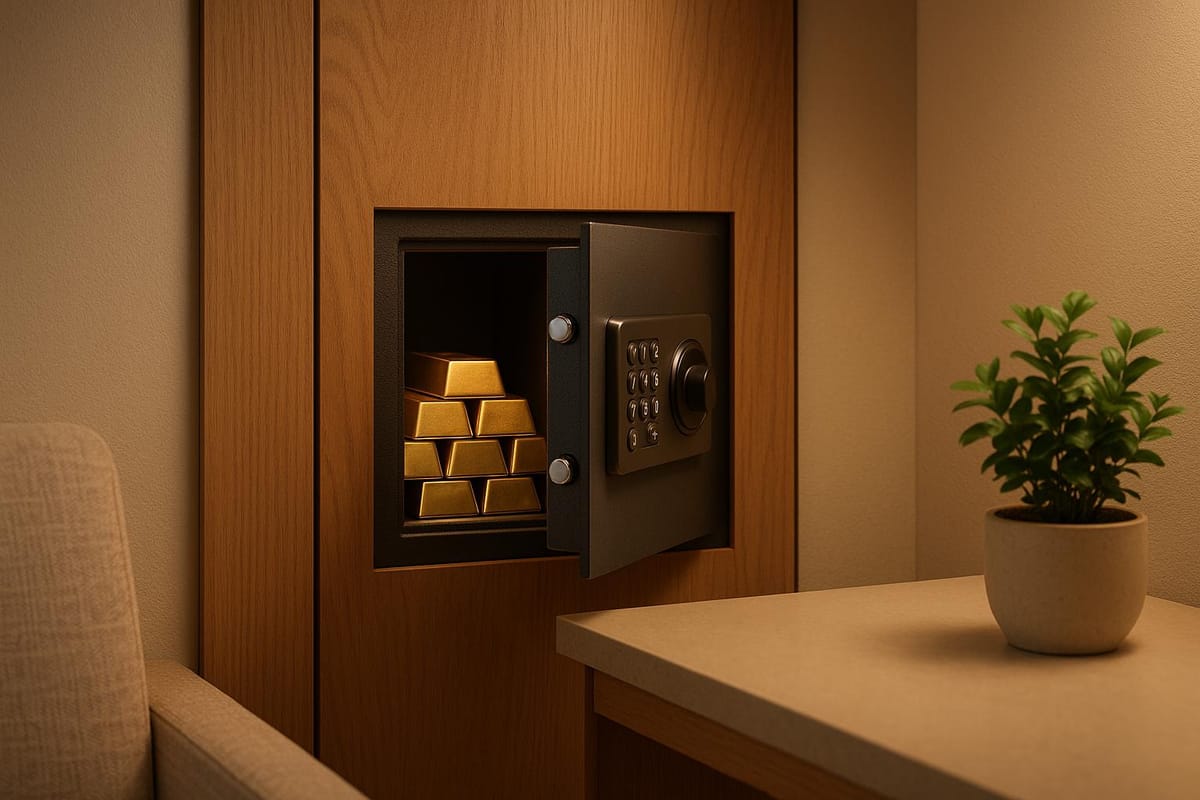How to Store Gold Safely at Home
Learn effective strategies for safely storing gold at home, from choosing the right safe to environmental protection and hidden compartments.

Want to keep your gold safe at home? Here’s what you need to know:
- Invest in a Secure Safe: Choose a UL-rated safe (like TL-15 or TL-30) for strong protection against theft, fire, and water damage. Look for features like fireproofing, waterproofing, and secure locks.
- Pick the Right Spot: Avoid obvious locations like the master bedroom. Consider hidden wall safes, basements, or creative spots like behind appliances or artwork.
- Use Hidden Compartments: Combine safes with discreet hiding spots (e.g., false ceilings, non-functional pipes, or modified household items) for extra security.
- Upgrade Home Security: Install a home alarm system, cameras, motion sensors, and reinforced doors to deter intruders.
- Protect Against Damage: Store gold in airtight containers, maintain stable temperatures (61-68°F), and control humidity (35-55%). Use silica gel packets to prevent moisture.
- Insure and Document: Standard homeowner policies don’t cover gold bullion. Get specialized insurance, keep detailed records, and update appraisals regularly.
Quick Tip: Spread your gold across multiple secure locations to minimize risk and keep a record of where everything is stored.
Where I Keep My Gold - How To Store Gold At Home Etc.
Choosing the Right Safe for Gold Storage
Investing in a reliable safe is a must if you want to protect your gold from theft, fire, or water damage. Picking the right one involves understanding the key security features and ratings that make a safe suitable for gold storage.
Key Features to Look for in a Gold Safe
Start with burglary protection. Look for safes with UL ratings, specifically a Residential Security Container (RSC) rating at minimum. For higher-value collections, consider safes with TL-15 or TL-30 ratings, which indicate resistance to attacks for 15 and 30 minutes, respectively. These ratings reflect a safe's ability to withstand tools like crowbars and sledgehammers. For example, the SentrySafe Waterproof and Fireproof Digital Safe (SFW123GDC) endured 30 minutes of such testing in a 2025 review by Business Insider, showcasing the value of robust UL ratings.
Fire protection is another must-have feature. Choose a safe with a UL fire rating that specifies the temperature and duration it can withstand. For instance, a safe rated for one hour at 1,700°F offers solid protection. In testing, the SentrySafe model mentioned earlier exceeded its classification, keeping contents intact after nearly two hours in a fire.
Waterproofing is equally important, especially for safeguarding against floods. Look for ETL-verified waterproof safes. However, keep in mind that some models excelling in fire and burglary resistance may not perform as well in water submersion tests.
When it comes to locks, strike a balance between security and convenience. Options include digital keypads, biometric locks, and traditional combination locks. A popular choice is the Viking Security Safe VS-20BLX Mini Biometric Safe, known for its fingerprint access and sturdy build, though it lacks fire and water protection.
Weight and installation are also critical. A heavy safe is harder to move, but even lightweight safes can be secure if they’re bolted down. Look for safes made from alloy steel and equipped with pre-drilled anchor holes for secure installation.
Finally, consider interior features like LED lighting and removable shelves. These make it easier to organize and access various forms of gold, whether coins, bars, or jewelry. Plan for the future, too - your gold collection may grow over time, so choose a safe that can accommodate increasing value.
Where to Place Your Safe at Home
Once you’ve picked a secure safe, where you place it is just as important. Intruders often head straight for obvious spots, so choosing an unexpected location can make a big difference.
Avoid the master bedroom. Studies show that 75% of burglars check the master bedroom first, and since most burglaries last only 8 to 10 minutes, hiding your safe in a less obvious spot can discourage theft. As Louis Chavez, a global principal engineer with UL, advises:
"Common places to avoid, because they are obvious to burglars, include bedroom closets and bedroom dresser drawers."
Think about alternative locations that still provide easy access. Wall safes hidden behind artwork are great for concealment. You could also integrate a safe into less conventional areas like the kitchen or laundry room, blending it in with everyday items.
Other options include basements, attics, and crawl spaces, though these come with pros and cons. While these spots can keep a safe out of sight, they might not be convenient for frequent use. If you’re considering an attic, make sure the floor can handle the weight - large safes can exceed 1,000 pounds and may cause structural issues.
For maximum security, consider building the safe into your home’s structure. Wall safes or under-floor installations are much harder for thieves to remove than portable models. Environmental factors also play a role. For fire protection, place the safe in a ground-floor corner where two exterior walls meet. For flood protection, keep it above ground level, ideally on a concrete or steel base. If you opt for a closet, bolt the safe to the subfloor framing for added security.
Always anchor your safe, no matter where you place it. A lighter safe that’s bolted securely can often provide better security than a heavier one that’s just sitting in place.
Hidden Compartments and Concealment Methods
When it comes to storing gold securely, combining a reliable safe with hidden compartments can provide an extra layer of protection. Hidden compartments add a discreet element, making it harder for intruders to locate your valuables. Together, these methods create a multi-layered security system.
Common Hidden Storage Options
-
Structural Hiding Spots:
Take advantage of your home's structural features, like false ceilings, spaces behind drywall, gaps behind radiators, or areas behind large appliances, to discreetly stash gold. -
Household Item Modifications:
Everyday items can be modified to hide valuables. Think about using freezers, gardening pots, pet beds, or even litter boxes as clever hiding places. -
Creative Outdoor Options:
Outside your home, artificial rocks with built-in cavities or burying gold deeper than 5 feet in the backyard can be effective. Mark the spot subtly, perhaps with a plant or other natural feature. -
Structural Modifications:
Non-functional pipes, unused fireplace spaces, or even drilled-out wooden logs can be transformed into secure, hidden compartments.
The key is to choose locations that blend naturally into your environment, making them less likely to draw attention.
Hidden Compartments vs. Safes: Which is Better?
| Factor | Hidden Compartments | Safes |
|---|---|---|
| Security | Relies on concealment and surprise | Offers strong physical protection and built-in security features |
| Cost | Typically less expensive for home modifications | Higher investment for quality, UL-rated safes |
| Fire Protection | Depends on materials and location | Many models include certified fire resistance |
| Water Protection | Varies based on setup | Some safes are designed to resist water damage |
| Accessibility | Quick access once the location is known | Requires codes or keys, but designed for ease of use |
| Installation | Often a DIY project | May require professional installation for optimal performance |
| Capacity | Limited by available space | Comes in various sizes to suit different storage needs |
| Theft Deterrence | Highly effective if the spot remains undiscovered | A visible safe can deter theft while securely holding valuables |
By combining these methods, you can create a well-rounded security plan that balances discretion and durability.
Common Hiding Spot Mistakes to Avoid
While hidden compartments and safes offer great options, there are mistakes that can undermine their effectiveness. Here's what to watch out for:
-
Obvious and Accessible Locations:
Avoid hiding gold in places that are commonly searched, like bedrooms, entryways, or living room furniture. -
Overtly Modified Spaces:
If a hiding spot looks unnatural or out of place, it could attract unwanted attention. Ensure that any modifications blend seamlessly with their surroundings. -
Sharing Location Details:
The more people know about your hiding spots, the greater the risk. Keep the location confidential, sharing details only with those who absolutely need to know. -
Relying on a Single Spot:
Putting all your gold in one place is risky. Instead, spread it across multiple discreet locations. This approach minimizes the chances of losing everything if one spot is discovered. Be sure to keep a secure record of where everything is stored.
Improving Home Security for Gold Storage
Once you've chosen your safe and concealment methods, it's time to focus on overall home security. Think of your security measures as layers of protection - each one adding a barrier that makes your home a less appealing target for thieves.
Multiple Security Layers
A quality home security system with 24/7 monitoring is a strong foundation. On average, homeowners invest between $2,000 and $5,000 upfront for such systems, plus monthly monitoring fees.
Surveillance cameras are a must-have. Modern AI-powered cameras can detect unusual activity and send instant alerts . To maximize coverage, install cameras at all entry points, ensuring no blind spots around your home.
Motion sensors paired with outdoor lighting are another critical layer. These lights activate when motion is detected, making it harder for intruders to move unnoticed - especially near windows and doors where break-ins are most likely.
Access control measures like reinforced doors, high-quality locks, and secure windows add another layer of defense. These barriers slow down intruders, giving your alarm system time to alert monitoring services or law enforcement.
For optimal security, integrate all these elements - cameras, sensors, alarms, and access controls. Many modern systems can automate responses. For instance, a motion sensor could trigger cameras to record and send alerts directly to your smartphone.
"Your security system is only as strong as its weakest link." - Brandon S., Editor, Hard Assets Alliance
Smart technology features bring added convenience. Cloud storage ensures your video footage remains accessible, even if your equipment is damaged or stolen.
Discretion matters when it comes to securing gold. While visible deterrents like cameras can discourage intruders, overly elaborate setups might attract unwanted attention. Strike a balance by combining visible and hidden security measures to keep your storage discreet.
Beyond physical defenses, proper documentation and tailored insurance are crucial for full protection.
Record-Keeping and Insurance Tips
After securing your home, protect your gold investment with meticulous record-keeping and specialized insurance. Even the best security plan isn't complete without these additional layers.
Standard homeowners insurance typically excludes bullion, so you'll need a specialized policy with specific requirements for home-stored gold.
Detailed inventory records are essential. Include photographs, weights, and descriptions of each gold piece, along with purchase dates (MM/DD/YYYY) and their value in U.S. dollars ($1,000.00). Store these records separately from your gold - options include a bank safety deposit box or secure cloud storage.
Consider a valuable items policy or precious metals rider for insurance coverage. Premiums often range from 1-2% of your collection's value annually. For example, insuring $50,000.00 worth of gold would cost $500.00-$1,000.00 per year.
Insurance requirements often mandate specific security measures. Insurers may ask for proof of a high-quality safe, professional installation, and a comprehensive home security system before issuing coverage.
Regular appraisals ensure your insurance aligns with market changes. Update your coverage annually or whenever gold prices rise significantly. Appraisals should follow U.S. standards and list values in U.S. dollars.
Emergency access planning is another consideration. Designate trusted family members to have access to security codes and storage details. Keep this information in sealed envelopes stored securely, and update it whenever you change codes or move your storage.
Finally, be mindful of contractor access during home repairs or renovations. Temporarily relocate your gold or increase security monitoring when workers are present. Many thefts occur when contractors notice valuables during routine visits, so this precaution adds an important layer of protection for your gold investment.
Protecting Gold from Damage
Beyond safeguarding gold from theft, it’s equally important to shield it from environmental factors that could harm its condition. While gold is known for its durability, proper care is essential to maintain its value over time.
Maintaining Proper Storage Conditions
Keeping gold in the right environment is crucial. Aim for a temperature range of 61-68°F (16-20°C) to avoid the risks associated with extreme temperature changes. Humidity is another key factor - levels should remain between 35-55%. Though pure gold doesn’t tarnish, items made with gold alloys can deteriorate in high humidity. Humidity above 60% can speed up tarnishing, especially for pieces containing silver.
An air-conditioned room is ideal for storing gold, as it ensures stable conditions throughout the year. Avoid placing gold in areas exposed to direct sunlight, such as near windows, and steer clear of high-humidity spaces like bathrooms or basements, where moisture levels can fluctuate significantly.
To monitor conditions, invest in a hygrometer and thermometer. Digital models can provide continuous readings for convenience. If you notice elevated humidity, a dehumidifier can help bring levels back into the safe range. Additionally, consider raising your safe a few inches off the ground to protect against minor flooding. For added moisture control, silica gel packets are a simple, low-cost solution that can be placed inside storage containers.
Once environmental conditions are under control, the next step is ensuring proper packaging to prevent physical damage.
Packaging Gold for Long-Term Storage
Packaging is just as important as storage conditions when it comes to protecting gold. To avoid scratches, store each piece individually. Airtight containers are your best bet for blocking out humidity and contaminants. For coins and small bars, consider using plastic storage capsules, tubes, or sealed blister packs. Jewelry, on the other hand, is best stored in soft pouches or velvet-lined boxes.
Use materials that won’t react with gold, such as acid-free paper, soft fabrics, or compatible plastics. Steer clear of materials that might chemically interact with gold over time. It’s also wise to store gold items separately from silver, as silver can release compounds that could affect gold alloys.
If possible, keep gold in its original packaging. For example, gold coins often come in protective plastic that provides an extra layer of moisture resistance. When storing jewelry, wrap each piece in a soft cloth or microfiber pouch to prevent scratches, and for added cushioning, you can place the wrapped item inside a piece of clothing. Anti-tarnish materials can also be incorporated into your storage setup for additional protection.
Regular Inspection and Maintenance
Routine inspections are essential for catching potential issues early. Check your gold regularly for signs of tarnishing, scratches, or moisture damage. Ensure that storage containers remain airtight and that moisture-absorbing products, like silica gel packets, are still functioning effectively.
When cleaning gold, use a soft, lint-free cloth to gently remove dust or smudges. Avoid abrasive materials or harsh chemicals that could damage the surface. Additionally, keep an eye on the temperature and humidity levels in your storage area, as these can shift with seasonal changes. If you notice consistent problems, such as moisture buildup or temperature fluctuations, consider upgrading your storage setup or relocating your gold to a more stable environment.
Lastly, inspect your safe periodically to ensure it’s in good condition. Pay close attention to door seals and the overall structural integrity of the safe. Taking these proactive steps will help preserve the condition and value of your gold investment over the long term.
Conclusion: Key Takeaways for Secure Gold Storage
Storing gold safely at home requires a mix of strong physical defenses, smart concealment, and careful environmental management. These combined efforts create a solid security plan, as detailed earlier. Focus on discreet placement and maintaining proper storage conditions to protect your investment.
Start with a UL-rated safe (like TL-15 or TL-30) as your first line of defense. This provides a sturdy barrier against theft. To strengthen your security further, consider advanced systems like 24/7 surveillance with cameras and motion sensors, which not only deter intruders but also notify authorities in case of a breach. Reinforce entry points with steel door-sets and frames to enhance the overall security of your home.
When it comes to preserving your gold, store it in a cool, dry, and shaded area to avoid damage from temperature changes. Use airtight containers and individual pouches to prevent scratches and chemical reactions.
Routine upkeep is critical. Clean your gold periodically with a soft, non-abrasive cloth to keep it looking its best. Regularly inspect your storage setup for any signs of wear or damage. This includes checking your safe, monitoring environmental conditions, and keeping your inventory updated with photos and detailed descriptions for insurance purposes.
While home storage offers the convenience of quick access and personal control, it also requires a strong security plan. Don’t overlook the importance of specialized insurance, as standard homeowner policies often fall short when it comes to covering bullion.
FAQs
What should I look for when choosing a safe to store gold at home?
When choosing a safe to store gold at home, focus on strength, security features, and installation methods. Opt for a safe built with heavy-duty steel and a solid design, as these qualities make it much harder for intruders to access. Ideally, the safe should weigh over 1,000 pounds or come with the option to bolt it securely to the floor, making it nearly impossible to remove.
Pay attention to the locking mechanism - look for a UL-rated mechanical or electronic lock for reliable protection. For even greater security, consider safes with dual locks or redundancy systems. It's also wise to select a safe with a fire-resistant rating to shield your gold from potential fire damage. Finally, where you place and conceal the safe in your home can make a big difference in keeping your valuables secure.
What are the best ways to hide gold at home to keep it safe from theft?
To protect your gold from theft, think about storing it in clever, unexpected spots throughout your home. Use non-metallic containers like plastic or ceramic to keep it undetectable by metal detectors. You can also conceal your gold in everyday objects, such as hollowed-out books, behind fake wall outlets, or even within pieces of furniture. Another option is a hidden safe, tucked away in places like under floorboards or behind a false panel.
Splitting your gold into multiple hiding places is a smart move. This way, if one spot is discovered, the rest remains safe. Just make sure your chosen locations are discreet and steer clear of common hiding places like mattresses or drawers.
What’s the best way to protect gold stored at home from damage?
To keep your gold in top condition at home, store it in a cool, dry, and elevated spot to protect it from moisture and potential flooding. Opt for airtight containers or capsules to shield it from tarnish and corrosion, and always store gold separately from other metals that may already show signs of tarnishing. Steer clear of plastic bags, as they can trap moisture and increase the chance of damage.
For extra security, use a durable, locked safe placed in a discreet location in your home. This not only reduces the risk of theft but also keeps your gold safeguarded from environmental harm.



